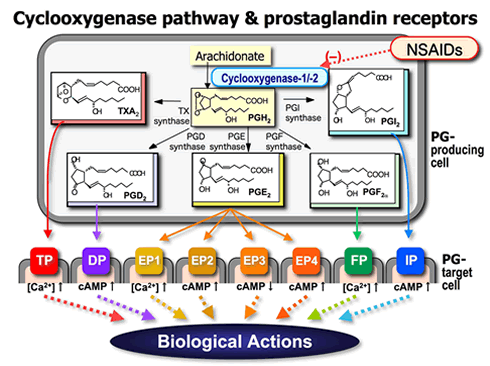スタッフ
| 教授 | 杉本 幸彦 ysugi(アットマーク)kumamoto-u.ac.jp |
|---|---|
| 講師 | 土屋 創健 sokent(アットマーク)kumamoto-u.ac.jp |
| 助教 | 稲住 知明 tinazumi(アットマーク)kumamoto-u.ac.jp |
研究テーマ
【研究プロジェクト名および概要】
- アスピリンの標的分子・プロスタグランジン(PG)は、発熱や疼痛、炎症作用をはじめ、さまざまな組織で多彩な作用を発揮します。PGの作用は8種類の受容体サブタイプを介して発揮されます(図)が、そのアウトプットは受容体を発現する細胞内外の環境に大きく依存し、作用発現の分子機構は不明です。薬学生化学講座では、8種類のPG受容体欠損マウスを駆使し、神経・免疫・生殖系における時空間特異的なPGシグナルの生理的意義と分子機構の解明をめざすとともに、創薬への応用を探ります。
- マスト細胞の部位特異的な新規機能の探索と創薬への応用
- マイクロRNAによる食道扁平上皮癌の制御機構と治療への応用
図1.
シクロオキシゲナーゼ経路により産生される5種類のプロスタグランジンは、8種類の受容体を介してさまざまな生理・病態作用を発揮する。
【研究テーマのキーワード】プロスタグランジン、プロスタグランジン受容体、エイコサノイド、アスピリン、非ステロイド性抗炎症薬、脂質メディエーター、メタボローム、シングルセル、ノックアウトマウス、GPCR、立体構造、急性炎症、アレルギー、自己免疫疾患、慢性炎症、マスト細胞、自然免疫、獲得免疫、女性生殖生理、代謝性疾患、接触皮膚炎、食道癌、マイクロRNA、トランスクリプトーム、ゼブラフィッシュ、発生、血液幹細胞、血管新生
Fig.1.
Five prostaglandins synthesized by cyclooxygenase pathway exert a wide variety of actions via eight types and subtypes of receptors expressed on neighboring cells.
Key Words
Prostaglandins, Prostaglandin receptors, Eicosanoids, Aspirin, Non-steroidal anti-inflammatory drugs, Lipid mediators, Metabolome, Single cell-based analysis, Knock-out mice, GPCR, Structure-function relationship, Acute inflammation, Allergy, Auto-immune diseases, Chronic inflammation, Mast cells, Inate immunity, Acquired immunity, Female reproduction, Metabolic diseases, Contact dermatitis, Esophageal cancer, Micro-RNA, Transcriptome, Zebrafish, Development, Hematopoietic stem cells, Angiogenesis
- Aspirin-like drugs elicit their therapeutic effects through suppression of biosynthesis of prostaglandins (PGs), which exert a wide variety of actions by acting on the PG receptors on the neighboring cells (Fig.). The final output of PG actions has been shown to depend on both intracellular and extracellular circumstances, and their exact molecular mechanisms remain elusive. To clarify these points, we examine the effect of PG receptor deficiency on several processes and therein molecular events in the nervous, immune and reproductive systems.
- Identification of tissue-specific molecular function of mast cells and its application to drug discovery and prevention of immune diseases.
- Regulation mechanism of esophageal squamous cancer by micro RNAs (miRs) and its application to cancer therapy.


